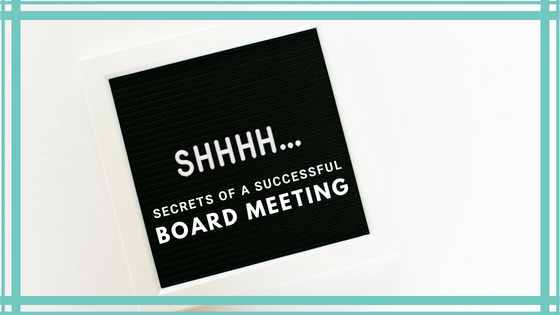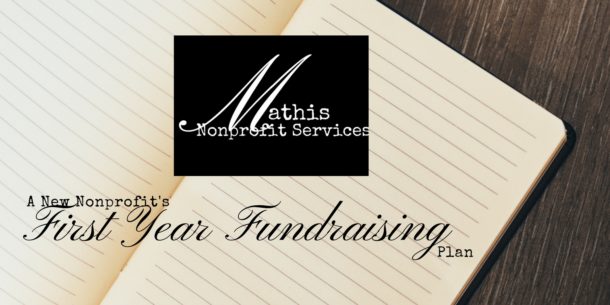Board meetings fall under time management in my book so today I’m sharing secrets of a successful nonprofit Board meeting and how to respect people’s time. Next Board meeting, try these Michael Hyatt, No Fail Meetings, inspired secrets.
Board Meeting Secrets
Preparation
Preparation is often overlooked on small Boards. There doesn’t seem to be enough time to get things done so Board prep falls on the priority list until it’s the day before and nothing is completed for the Board meeting. We’ve all been there. However, to respect everyone’s time at the Board meeting and in the times in between, Board members need to have the following in plenty of time for review.
- A detailed agenda. This agenda should include the purpose of the meeting, topics, time allotted for each topic, and action items.
- Minutes from the last meeting.
- Any other documents needed to be reviewed before a vote.
These items are often called a Board Packet and can be emailed or snail mailed. The packet needs to get in the hands of the Board members no later than a week before the meeting so they may review. Making this part of the reminder- email or not- for the meeting (something most bylaws require) will help you make good use of your time.
Communication is paramount between the Board President and the Secretary. Traditionally, the Secretary is responsible for the minutes at each meeting and the Board notices. His or her job is to record the meeting, participants, and discussion of the meeting for organizational records. This perspective may be different than an individual’s.
The Meeting
Make sure you are clear from the beginning you want to respect everyone’s time so you will have your facilitator keep strict time limits. I recommend the facilitator not be the Secretary but in a pinch, they could be. If there is still discussion after the time limit is up, this item will be tabled for the next Board meeting or a special called meeting to only discuss the item. Both of these options are for a later date.
Everyone is expected to take their own notes. This is a good practice because each individual can record their own thoughts or questions, their action items, and things of importance to them. It also helps people pay attention. Remember, it’s not the Secretary’s job to keep up with individual action items after the meeting or to record the meeting for an individual. It is the Board member’s.
Make sure there is a purpose for each item on the agenda and each Board member knows this purpose. Are you making a decision about the direction of the organization? Planning an event? Taking a vote on an issue? Before you begin discussing an agenda item, remind the Board why you are discussing this item and the result(s) you are looking for. An example:
Agenda Item: Spring Fundraiser
Purpose: We will be discussing the new Spring Fundraiser opportunity that has recently arisen in order to vote for approval or disapproval so the Fundraising Committee will have a direction to follow.
Each agenda item will have action items assigned to the appropriate people. The Secretary will record the action items for the organization. Again, each individual should make note of what they have agreed and committed to.
Reserve a few minutes at the end of the Board Meeting to review action items which were assigned. This will make sure everyone is leaving on the same page.
Follow Up
The Board President should follow up with each person assigned an action item at an appropriate time to see if the person working on the task has run into a roadblock or simply needs help with the item.This is not meant to micromanage the Board member but to help each Board member have success with the action item. Think of servant leadership here. It is the leader who holds the ultimate success of the failure of a meeting.
If you would like to read Michael Hyatt’s No Fail Meetings, you can buy it here. This link is not an affiliate link. I just think it can help anyone struggling with meetings.


 Most nonprofit leaders lay awake at night trying to figure out how to fund their mission.
Hi! I'm Alesha.
I teach sustainable fundraising in a way that they can take action today so they can serve their clients.
I can help you move from just getting started funding your new nonprofit to gaining confidence in your fundraising and building relationships to knowing what works for your organization and looking at the infinite game when it comes to funding. I’ve worked with nonprofit Founders and written the book I HAVE MY 501(C)3! NOW WHAT?!? Your Blueprint to Starting Your Nonprofit Without Being the Sole Funder that lays the foundations for funding in a new nonprofit.
I’ve worked in Development (Fundraising) Departments in large organizations and I know the no cost, low-cost methods they use to bring in funding. I bring those sound strategies to the nonprofits I serve.
Most nonprofit leaders lay awake at night trying to figure out how to fund their mission.
Hi! I'm Alesha.
I teach sustainable fundraising in a way that they can take action today so they can serve their clients.
I can help you move from just getting started funding your new nonprofit to gaining confidence in your fundraising and building relationships to knowing what works for your organization and looking at the infinite game when it comes to funding. I’ve worked with nonprofit Founders and written the book I HAVE MY 501(C)3! NOW WHAT?!? Your Blueprint to Starting Your Nonprofit Without Being the Sole Funder that lays the foundations for funding in a new nonprofit.
I’ve worked in Development (Fundraising) Departments in large organizations and I know the no cost, low-cost methods they use to bring in funding. I bring those sound strategies to the nonprofits I serve.